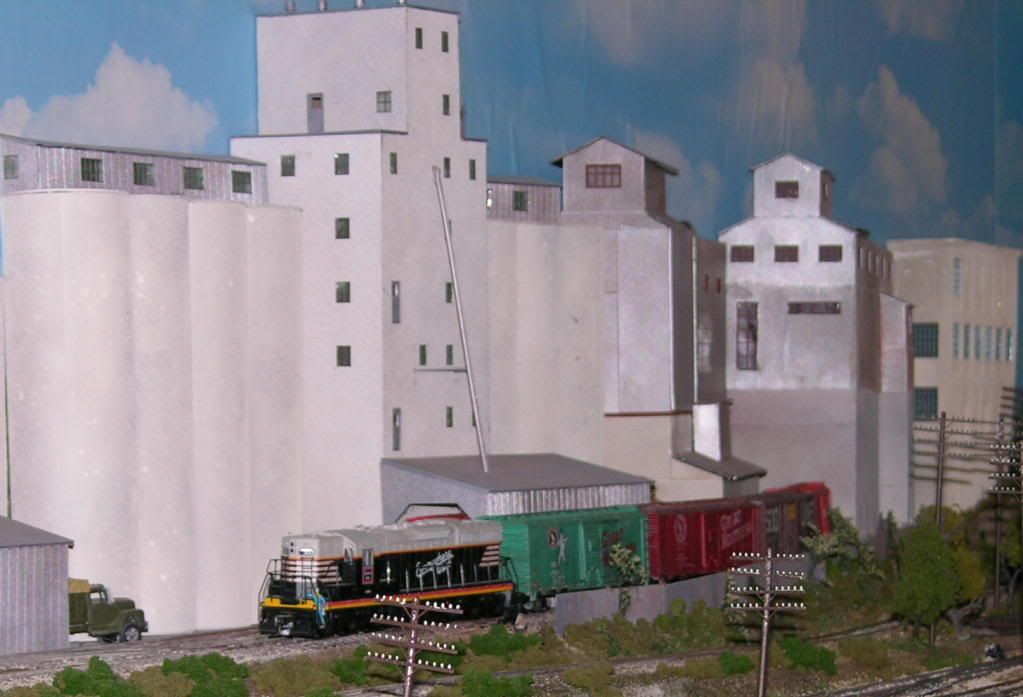Hi, I was wondering what was used to transport grain to feed mills in the late 50’s? I am planning a Northeastern freelance New Haven/ Boston&Maine. I saw a old feed mill in southern NH that I want to model.
Greg
Hi, I was wondering what was used to transport grain to feed mills in the late 50’s? I am planning a Northeastern freelance New Haven/ Boston&Maine. I saw a old feed mill in southern NH that I want to model.
Greg
Boxcars. There was a recent article on this in either Trains or MR.
They used boxcars like this one.

In the 1950’s common 40’ boxcars were assigned to grain service. They would place a barrier of cardboard or plywood inside the doorway to prevent spilling. Other types began to be more common in the 1960’s such as grain-loading boxcars and early design covered hoppers.

when i went to work on the Big Four back in the 60’s, the Q at E St Louis was so hard up for box cars to load grain in during the season that they paid a five dollar bounty for good, tight 40’ empties.
since we interchanged directly with them, we were always hijacking clean empty box cars and forwarding them to the Burlington regardless of ownership or car service rules. a little fly by night diversion.
their yardmaster kept the fund in a cigar box in his desk. cash on the barrell head. the average pay for a railroader back then was less than 25 dollars a day so the piracy paid off.
as for their thinking, it was better to pay the per-diem charges on foreign cars that to loose the revenue load.
modern day car accounting and interchange records would prevent such activity and now you would have to buy your own beer.
i heard that back in the old days, the wabash and other roads were into this too and when cars got really scarce, you could auction them off.
grizlump
Boxcars were used in grain service through the 1970s, especially on branchline tracks where light rail didn’t allow loaded 100-ton hoppers.
The first widely-used covered hopper cars to haul grain was Pullman-Standard’s 70-ton PS-2 introduced in the late 1950s. 100-ton covered hoppers were introduced in the1960s. Hoppers didn’t quickly take over the grain-hauling business because boxcars were more versatile while the hoppers were essentially single-commondity cars as well as railroads being heavily invested into boxcars…
Mark
What is the build date of the Northern Pacific boxcar
Greg
If the NP car is in it’s original paint scheme, it would be mid-sixties I believe. Before about 1962 NP boxcars would have been dark boxcar red except for plug-door cars which were dark green. I have a the same car only lettered for the Soo Line, I think the build date is 1961??
Generally in the fifties grain was in normal boxcars. They had “grain doors” back then that they could insert in the doorways that covered up all but a foot or so along the top, so you could insert one of those hose deals and fill the car with loose grain. As mentioned, trains of 40’ boxcars were common on branchlines with light loading specs into the 1970’s and I believe even later in Canada.
Although this car was used to transport clay it is like a car used to transport grain. Not all cars had the hatches many were straight 40’ boxcars. But this car has a grain door installed showing the foot at the top of the car.

Rick
The cardboard from graindoors had many uses. Had not thought of them for quite a while
Thank You
The preferred car was a 40 ft “tall,skinny door” boxcar. A 40 ft boxcar with 6 ft doors. It would have to be in fairly good shape with a tight roof and floor. The NP car was a very small part of the fleet. Most grain was handled in plain 40 ft boxcars.
The green NP car has an ACI label which puts it between 1968 and 1978 or so. Not a build date, but a repaint. Since the BN merger happened in 1970, that futher limits the plausible date for the car with that appearance.
–Randy
The BN ‘Cascade Green’ paint on NP cars is correct for 1968-1970. The NP used ‘Cascade Green’ on several classes of freight cars and even on a new order of wide vision cabooses. The CB&Q was repainting freight cars with the new green, and even received new locomotive in a modified version of the green paint scheme. The GN was repainting passenger cars in the new BN paint scheme as well.
Jim
Agreed. I would not use a boxcar with any door wider than 6 feet. Yes, it may have happened, since I have learnt never to say never, but the narrow opening made it a lot easier to seal it up so the grain didn’t leak out (much) through the door. Furthermore, the wider door cars were usually in demand for other more profitable loadings where the shipper preferred a wider opening. This was especially true in Canada where the legislated Crow Rate meant the railroads were losing money on grain transportation by the 1960s, if not before. Some boxcars actually had hoppers in the bottom, but major grain terminals had machinery to tilt and shake standard boxcars to empty them through the doors (first removing the temporary inner grain “door”).
John
I just picked up a 2 pack of Walthers 40ft wood box cars with grain doors! Paid $9 for them, what a deal!